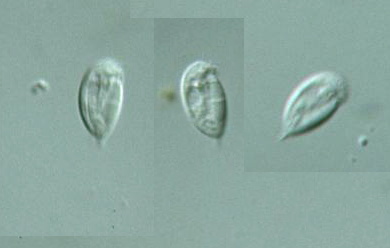

Phyllopharyngea:
Cyrtophorida: Dysteriina: Dysteriidae
Dysteria navicula
Kahl, 1928
 Genus: Cilia in groove, opening to right; margins smooth; body kineties complete (Illustrated Guide, 1985).
Usually ovoid, ventral surface flattened; dorsal domed and longitudinally ribbed with a cleft on the right
lateral edge; a large podite with secretory canal posterior; somatic ciliation restricted to ventral
surface; a large macronucleus central; two contractile vacuoles (Carey, 1992).
Genus: Cilia in groove, opening to right; margins smooth; body kineties complete (Illustrated Guide, 1985).
Usually ovoid, ventral surface flattened; dorsal domed and longitudinally ribbed with a cleft on the right
lateral edge; a large podite with secretory canal posterior; somatic ciliation restricted to ventral
surface; a large macronucleus central; two contractile vacuoles (Carey, 1992).
Species:
Cell body elogated ovoid, small, up to 35 μm long;
similar to D. calkinsi but rather longer; a single macronucleus with two micronuclei
(Carey, 1992).
|
Dysteria navicula Kahl, 1928 ?,
cell body 23 μm long, 12 μm wide,
x 400, x 640, Japan, May-June 1999 by Y. Tsukii
 50 μm
50 μm
 100 μm
100 μm
 150 μm; x 400 :
150 μm; x 400 :
 31 μm
31 μm
 63 μm
63 μm
 94 μm; x 640
94 μm; x 640




Dysteria navicula Kahl, 1928:
Ovoid, elongate, up to 35 μm long;
no ribs on dorsal surface; but cleft on the right very wide; similar to D. calkinsi
but longer in the body (posterior end slightly tapered); a single macronucleus and
two micronuclei (Carey, 1992).
* Dysteria calkinsi (Calkins, 1902) Kahl, 1931:
Ovoid, 45 μm long; cleft on the right of the body
very wide in anterior; cytopharyngeal apparatus simple; six macronuclei and two
contractile vacuoles (Carey, 1992).
Please click on images for viewing enlarged.
Copyright
Protist Information Server
 Genus: Cilia in groove, opening to right; margins smooth; body kineties complete (Illustrated Guide, 1985).
Usually ovoid, ventral surface flattened; dorsal domed and longitudinally ribbed with a cleft on the right
lateral edge; a large podite with secretory canal posterior; somatic ciliation restricted to ventral
surface; a large macronucleus central; two contractile vacuoles (Carey, 1992).
Genus: Cilia in groove, opening to right; margins smooth; body kineties complete (Illustrated Guide, 1985).
Usually ovoid, ventral surface flattened; dorsal domed and longitudinally ribbed with a cleft on the right
lateral edge; a large podite with secretory canal posterior; somatic ciliation restricted to ventral
surface; a large macronucleus central; two contractile vacuoles (Carey, 1992).



